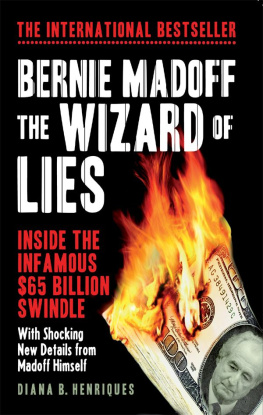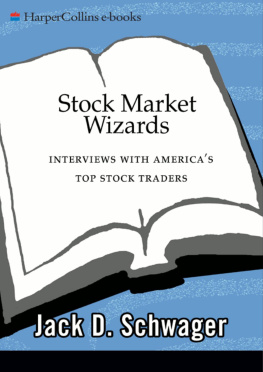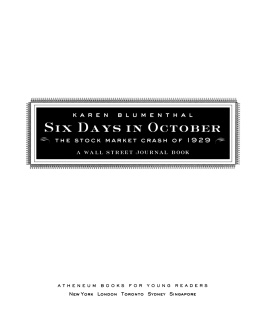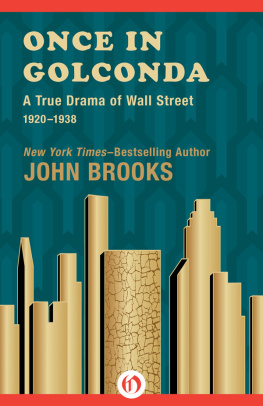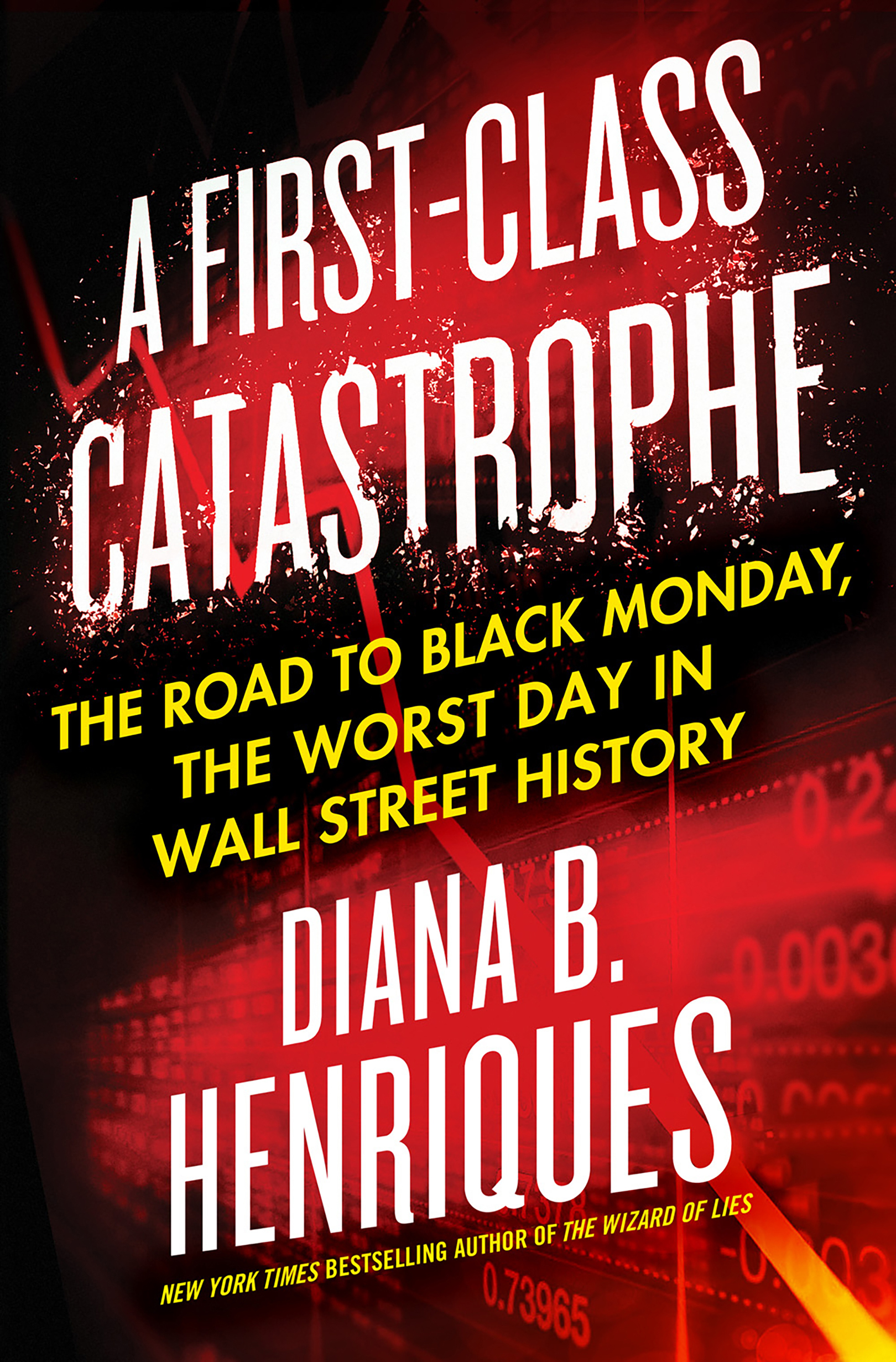Contents
Guide
Pagebreaks of the print version

The author and publisher have provided this e-book to you for your personal use only. You may not make this e-book publicly available in any way. Copyright infringement is against the law. If you believe the copy of this e-book you are reading infringes on the authors copyright, please notify the publisher at: us.macmillanusa.com/piracy.
For Floyd Norris
admired colleague, trusted mentor, cherished friend
WASHINGTON
BANK REGULATORS AND WHITE HOUSE OFFICIALS
Howard H. Baker Jr. , White House chief of staff (198788)
James A. Baker III , White House chief of staff (198185) and secretary of the Treasury (198588)
Nicholas F. Brady , chairman of the Presidential Task Force on Market Mechanisms (198788) and secretary of the Treasury (198893)
C. Todd Conover , comptroller of the currency, an independent official within the Treasury Department (198185)
E. Gerald Corrigan , vice president of the Federal Reserve Bank of New York and special assistant to New York Fed President Paul Volcker (197680), president of the Federal Reserve Bank of Minneapolis (198084), and president of the Federal Reserve Bank of New York (198593)
Alan Greenspan , chairman of the Federal Reserve System from August 1987 to January 2006
William M. Isaac , chairman of the Federal Deposit Insurance Corporation (198185)
Donald T. Regan , secretary of the Treasury (198185) and White House chief of staff (198587)
Paul A. Volcker , president of the Federal Reserve Bank of New York (197579) and chairman of the Federal Reserve System (197987)
STOCK MARKET REGULATORS
Richard G. Ketchum , director of market regulation at the U.S. Securities and Exchange Commission (198391)
David S. Ruder , chairman of the SEC (198789) and former dean of the Northwestern University School of Law
John S. R. Shad , chairman of the SEC (198187) and the former vice chairman of E.F. Hutton and Co.
Harold M. Williams , chairman of the SEC (197781)
FUTURES MARKET REGULATORS
Wendy Gramm , chairman of the Commodity Futures Trading Commission (198893)
Kalo A. Hineman , acting chairman of the CFTC (198788)
Philip Johnson , chairman of the CFTC (198183) and longtime legal counsel to the Chicago Board of Trade
Susan M. Phillips , a CFTC commissioner (198183) and chairman of the CFTC (198387)
James M. Stone , chairman of the CFTC (197981) and a CFTC commissioner (198183)
WALL STREET
W. Gordon Binns Jr. , investment manager for the General Motors pension fund (198194)
Robert J. Birnbaum , president of the American Stock Exchange (197785) and president of the New York Stock Exchange (198588)
Roland M. Machold , director of the New Jersey Division of Investment and manager of the states pension funds (197698)
John J. Phelan Jr. , vice chairman of the NYSE (197580), NYSE president (198084), and NYSE chairman and CEO (198491)
CHICAGO
William J. Brodsky , executive vice president and chief operating officer of the Chicago Mercantile Exchange (198285), and president of the Merc (198596)
Leo Melamed , chairman of the Chicago Mercantile Exchange (196973, 197677), special counsel to the Merc (197785), and chairman of the Merc executive committee (198591)
Richard L. Sandor , chief economist and vice president of the Chicago Board of Trade (197275), and a former business school professor at the University of California at Berkeley
BERKELEY
Hayne E. Leland , a Harvard-educated economist who joined the business school faculty at the University of California at Berkeley in 1974
John OBrien , a founding partner, with Leland and Mark Rubinstein, of Leland OBrien Rubinstein Associates and its chief executive (198197)
Mark Rubinstein , an options pricing theorist and finance professor who joined the business school faculty at the University of California at Berkeley in 1972
R. Steven Wunsch , a vice president at Kidder Peabody in the 1980s, specializing in derivatives, and an informal adviser to LOR Associates
It is difficult to convey to a modern audience the emotional impact of the stock markets gyrations in the 1980s, or indeed in any distant decade, because the most popular measures of market value have grown so much in the intervening years.
For example, on the worst day of the 1929 crash, the Dow Jones Industrial Average lost about 38 points, an insignificant move in modern markets. But on that day, the Dow had opened at just under 300 points, so that 38-point drop represented an unprecedented 12.8 percent decline. That record stood until the crash of 1987.
Similarly, the Dows daily point swings in this story may sound unremarkable at a time when the index is calculated in five digits. At this writing in early 2017, the Dow has surpassed 20,000 points, but for much of the early 1980s, the index hovered between 1,000 and 1,500 points. To feel the modern punch of the markets gyrations in those years, double the long-ago Dow points and add a zerothus, a loss of just 50 points back in early 1981 would be roughly equal to a 1,000-point drop in early 2017. For Dow point changes for the years after January 1987, when the index hit 2,000 points for the first time, just add a zero to the older figurethus, a 100-point drop in late 1987 loomed as large as a 1,000-point drop today. This rule of thumb, while not precise, will give some sense of how people in the 1980s perceived the markets historic moves. Of course, the percentage changes can provide a more exact comparison.
Time also has blurred the scale of monetary sums cited in this story. To get a general sense of the modern magnitude of those figures, triple the dollar amounts before 1985 and, thanks to declining inflation, double the dollar amounts after 1985.
On that historic autumn Monday, it seemed possible that the entire American financial system would crack apart. The next day, it seemed certain that it would.
The storm had not come out of a cloudless sky. There had been years of heedless expansion, months of growing anxiety, weeks of looming trouble and fading options. Then, Monday dawneda day so terrifying that those uneasy months and weeks seemed placid by comparison.
Global markets teetered. High-speed computer trading, driven by mathematical models, outran the pace of mere humans. Poorly understood derivatives set off depth charges everywhere, revealing hidden links that bound together the banks, insurers, giant investors, and big brokerage firms that populated Wall Street. Those connections stretched across all the regulatory borders that rival government agencies defended so fiercely. At the edge of the cliff, some questionably legal steps saved a key firm from collapse, a failure that would have tipped a crisis into a catastrophe.
For many, this chronology instantly calls to mind the financial meltdown that erupted on Monday, September 15, 2008, with the collapse of the Lehman Brothers brokerage firm. The day after Lehman Monday, the U.S. Treasury Department and the Federal Reserve were fighting frantically to rescue the massive insurance firm AIG, which neither agency officially regulated but which was linked to other giant firms around the world through a set of financial derivatives called credit default swaps. Those events triggered widespread panic that eclipsed almost anything the markets had seen since 1929.
Almost anything. Because the events just described, the events at the core of this story, did not happen in the harrowing weeks of September 2008. They happened on October 19, 1987, a day almost immediately dubbed Black Monday.


